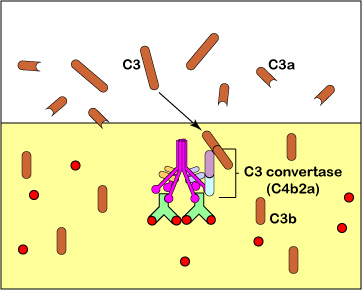
The C4b2a functions as a C3 convertase that can enzymatically cleave hundreds of molecules of C3 into C3a and C3b. C3b, and to a lesser extent C4b, attaches antigens to phagocytes for opsonization (enhanced attachment). One portion of the C3b binds to proteins and polysaccharides on microbial surfaces; another portion binds to CR1 receptors on phagocytes, B-lymphocytes, and dendritic cells. This results in improved phagocytosis. C3a can promote inflammatory responses that enable body defense cells and defense chemicals to leave the blood and enter the tissues.
Last updated: August, 2019
Please send comments and inquiries to Dr.
Gary Kaiser